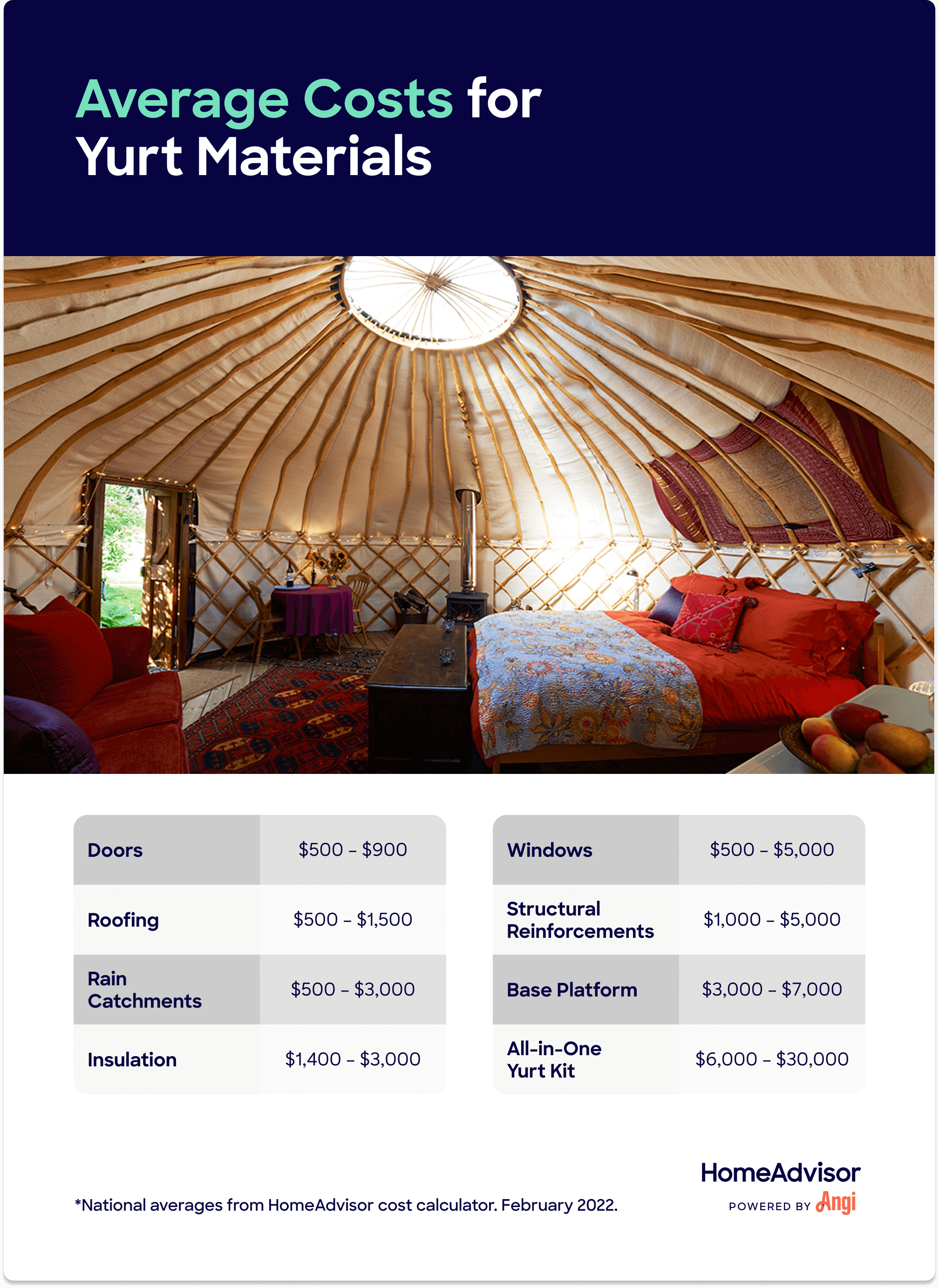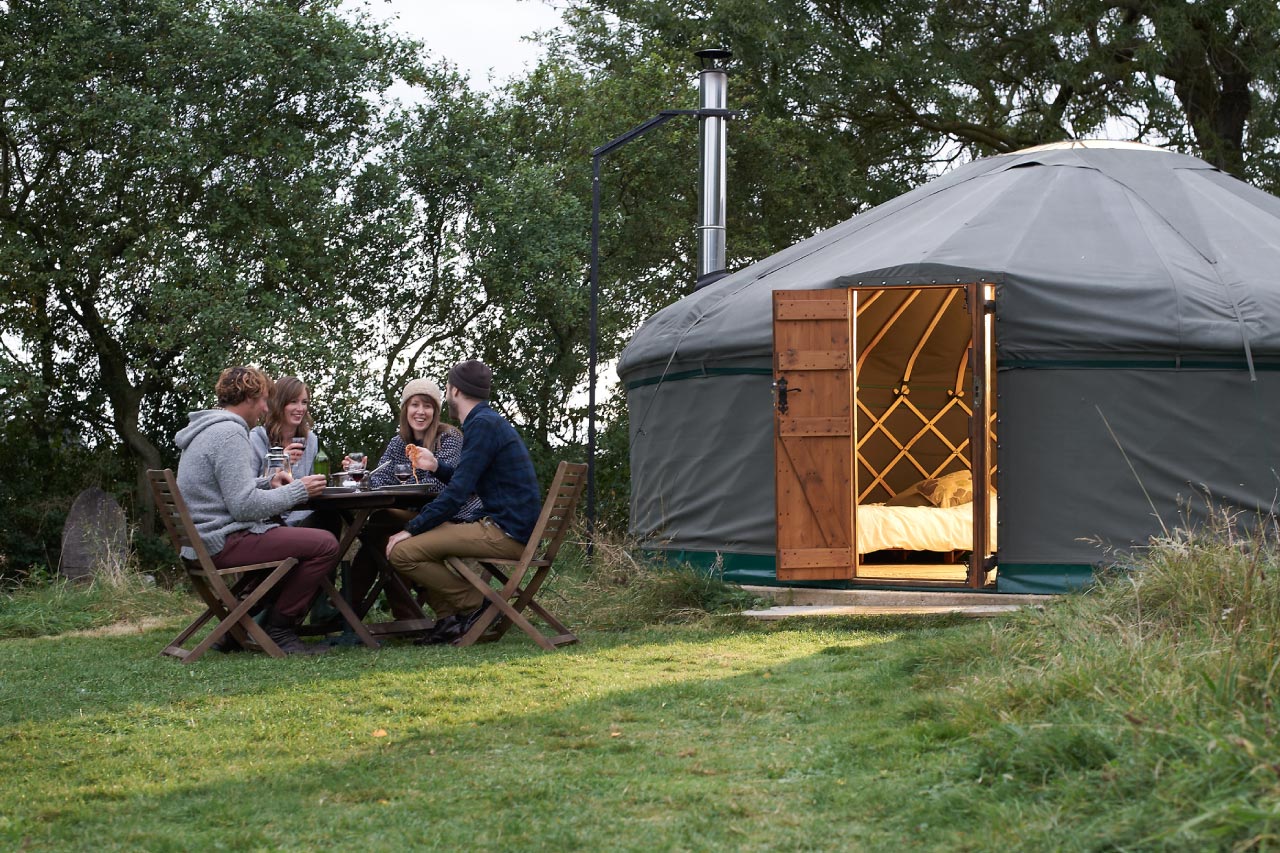How Much Does It Cost to Build a Yurt?
Typical Range:
$11,500 - $44,000
Typical Range:
$11,500 - $44,000
Cost data is based on research by HomeAdvisor.
Updated December 14, 2022
Written by HomeAdvisor.On average, you’ll spend $35,000 to build a yurt home or between $11,500 and $75,000. That price includes the yurt, base platform, and interior finishings. You’ll pay more for add-ons like an exterior deck, heating and cooling, wind and weather packages, custom kitchens, and upgrades with premium materials and features.
Essentially a large, round, reinforced building with a conical roof, these semi-permanent wood, metal, or fabric homes are quickly gaining popularity for vacation properties, off-grid living, and as tiny homes.
Find more information below on the cost factors for yurt installation, including different types and considerations for hiring a professional.
Materials make up most of the overall cost of building a yurt, or about $7,500 to $64,000. Most yurts are built as a kit in a factory by specialty builders and shipped to you when done. We’ll go into kit costs below, but you can also construct it from scratch or buy it in pieces. The yurt platform base, deck, plumbing, and electrical and interior walls and amenities are built on site, whether you buy a kit or not.
The materials you choose, your yurt’s size, labor, and potential permits all impact your yurt’s cost. Keep in mind that delivering your yurt to your home can also tack on 10% of your total project cost.
See the estimated average percentages your factors contribute to your total cost.
Materials and your yurt’s size make up 75% of your budget. The bigger your build, the more you’ll pay, regardless of the materials you choose.
Labor makes up about 10% of your budget. However, your location and the type of yurt will impact how much you pay.
Delivery makes up about 10% of your yurt project’s cost. Your price may be lower or higher, depending on your location, distance traveled, materials, and other factors.
Permits make up about 5% of your total cost. While they vary between locations, expect to pay $400 to $2,3000.
While it costs $35,000 on average to build a yurt, you can save significantly by DIYing a simpler, smaller yurt.
Every yurt needs a base platform. You’ll spend $3,000 to $7,000 on a standard base platform or $14,000 to $20,000 on a SIPS (structural insulated panels) base, which comes completely insulated for colder climates.
The base is the platform you’ll put the yurt on. The latticework attaches to it and the walls attach beneath it for a weather and bug seal. You’ll need to choose wood or composite. Trex costs a bit more, but doesn’t deteriorate like wood, nor does it have pest problems. You’ll also need concrete footings.
Insulation costs anywhere from $500 to $5,000 for a yurt, depending on the style and how much you use. Most manufacturers recommend insulating the floor with rigid foam, blocking off any openings under the structure, and putting radiant heat barrier insulation in the walls. They usually sell custom wall and roof insulation and liners.
Batt and roll insulation costs: $0.30–$1 per sq. ft.
Spray foam insulation costs: $0.50–$6.00 per sq. ft.
Radiant heat barrier costs: $0.10–$1.00 per sq. ft.
Rigid foam insulation costs: $0.25–$0.50 per sq. ft.
Structural reinforcements, beyond the standard latticework walls, costs $1,500 to $7,000 extra, depending on whether you install it yourself or have a pro do it. If you live in an area with extreme weather, you’ll want to reinforce your yurt with larger rafters, compression ring-to-rafter brackets, or studs around the perimeter.
All yurt kits include a basic roof, but if you’re replacing one, building your own, or upgrading to a more durable model, you’ll spend up to 20 times as much. Roofs range from $1,700 to $20,000 not including shipping. These ultra-durable options are reinforced for harsh climates and longer lifespans.
Top Cover: $1,700–$7,000
Roof Liner: $400–$2,000
Metal Roof: $5,000–$24,000
Most yurt kits come with basic plastic windows and a standard door, but you may want to upgrade for additional light or premium materials, like wood and glass.
Extra basic plastic windows: $100–$500 each
Upgraded glass windows: $1,300–$5,000 each
Dutch or French doors: $1,500–$2,500 each
Custom wood doors: $700–$2,000 each
Minimalist comfort features run $50 to $2,000, while installing a full bathroom, kitchen, deck, and outdoor living space can add $50,000 or more to the build. Essentially, you can make living in a yurt as austere or luxurious as you’d like by including additions both inside and outside. Total costs depend on how much you want to invest.
Kitchen installation cost: $10,000–$20,000
Bathroom installation cost: $5,000–$15,000
Deck building cost: $4,000–$11,000
Wood stoves cost: $900–$4,000
Dome cost: $550–$1,000
Stove flashing cost: $50–$100
Dome screen cost: $50–$100
Fan mount cost: $50–$75
Snow and wind kit cost: $550–$1,600
Gutters cost: $400–$1,200
Water tank cost: $100–$1,800
You’ll pay $2,00 to $5,000 for labor. Additions like a deck, glass windows, doors, a kitchen, or a bathroom can push labor costs towards $20,000 or more. Building from scratch drastically increases labor prices while kits go up in a day. The installs are DIY-friendly once the base platform installation wraps up. Location factors in: the more remote, the more you’ll pay.
Delivery costs $500 to $5,000 or more. If you have a large truck delivering a kit to a remote location, expect to pay a little more. Distance factors in: the farther your materials travel, the more you’ll pay. If you hire a local contractor to perform the build, they may bring the materials with them and wrap them into the job's overall cost.
Building permits cost $400 to $2,300. Small yurts, typically under 200 square feet, don’t require a building permit. In rural and remote locations, you’ll have varied regulations. Check with your local municipal code enforcement agency for requirements where you live. A contractor will know all about any required permits.
Yurts cost more the larger they are, ranging from $8,000 to $31,500 for the base kit. These prices don’t include any upgrades, which can quickly double the price; wood costs about $8,000 to $12,000 more than a fabric dwelling of the same size. The following table includes both fabric and wood yurts.
| Size (Diameter) | Starting Cost Range* |
|---|---|
| 12’ | $8,000 – $22,000 |
| 14’ | $9,000 – $23,100 |
| 16’ | $10,300 – $25,200 |
| 20’ | $12,500 – $28,100 |
| 24’ | $14,200 – $36,800 |
| 27’ | $16,100 – $39,200 |
| 30’ | $17,600 – $43,500 |
| 34’ | $22,000 – $50,000 |
| 40’ | $26,000 – $65,000 |
* Base package pricing, not including upgrades.
Yurt kits come complete with engineered solutions to save you time and money with no waste. They run $8,000 to $65,000 depending on the materials you choose and if you purchase a base platform kit.
They go up in a day
Incur almost no labor costs
Easier to ship to a remote site
Saves you money overall
Come in various sizes
Customizable at the factory
Range from 12’ to 30’
Your budget determines the size, material choice, and upgrades in your home. On the low end, you’ll get a small diameter with no upgrades, just standard options. On the high end, near $60,000 or above, you’ll enjoy the largest dwellings with upgraded kitchens, bathrooms, decks, and air conditioning.
$6,000–$8,000: Base package with no upgrades. Fabric only up to 12’ in diameter.
$8,000–$16,000: Fabric yurt up to 16’ in diameter or up to a 12’ basic wood yurt. No upgrades.
$16,000–$28,000: Base package fabric yurt up to 27’ in diameter or wood yurt up to 20’ in diameter. Upgraded packages with amenities up to 16’ in diameter.
$28,000–$36,000: Luxury fabric yurts up to 40’ in diameter or a wood style with metal roof up to 24’ in diameter. Wood luxury models up to 20’ in diameter.
$36,000–$50,000: Fully upgraded fabric yurts up to 33’ in diameter with kitchen and bath. Fully upgraded wood units up to 20’ in diameter. All base models from 27’ to 35’ in diameter.
$51,000–$75,000: Extreme luxury full sized wood or fabric yurts from 30’ to 40’ in diameter that include upgraded kitchens, baths, and an exterior deck.
You’ll tend to pay less hiring a professional yurt building company that creates the kits and installs them. But even then, they make extremely good DIY projects, with little help needed from contractors for the setup portion.
Most companies that supply kits also supply:
Plans for permits or DIY projects
Base platforms and plans
Delivery services
Installation services
More commonly, owners buy kits and install them as a DIY project then hire out a contractor to customize the inside once installed. Hire a local yurt builder for the kitchen, deck, and installing plumbing, air conditioning, and sewer. Leave electrical components to a contractor.
Building a yurt structure yourself saves some bucks, as you won’t pay for labor costs. You’ll likely want to go with a kit home. They’ll often come with plans for the base or you can purchase a base platform kit as well. You’ll need basic carpentry skills and some basic tools, such as:
Hammer
Landscaping shovel
Power drill
Circular saw
8-foot ladder
Hacksaw
Carpenter’s level
A yurt is a circular structure with a conical roof and a dome skylight for light and ventilation at the pinnacle. Traditionally made from fabric, it’s also available in more permanent materials like wood and metal. Some benefits that yurts offer include:
Less expensive than a traditional home
Natural heating and cooling in temperate climates
Only require a semi-permanent platform base
Offers various functions like a primary home, office, storage, or extra living space
Average yurt living costs $100 to $600 per month, less if you are completely off grid. Depending on the location, you may also have to pay annual property taxes or other fees.
A yurt can last 10 to 20 years with little more than maintenance before you’ll need to start replacing sections or doing any major repairs. Full wood and metal yurts can last 50 to 70 years with regular maintenance.
You can install a bathroom in a yurt or opt for an outbuilding instead. They’re not usually part of the base package, but an add-on.

